Abstract
The mechanism of CD4+ cell depletion and functional T helper cell inhibition in HIV-infected individuals is poorly understood. The present study demonstrates that immune complex-covered CD4+ cells are associated with T cell inhibition and macrophage stimulation. We studied 30 patients with ARC/AIDS and 35 asymptomatic HIV+ haemophilia patients. Overall, 20 +/- 3% of peripheral CD4+ lymphocytes were covered with gp120 (range 0-94%). gp120+ cells also exhibited surface-bound IgG (P = 0.0001), IgM (P = 0.0001), and complement (P = 0.0001). Decreased in vitro lymphocyte proliferation was associated with the immune complex load of CD4+ cells. The higher the percentage of CD4+ gp 120+ cells in the blood, the lower the T cell response in vitro (P = 0.001). Moreover, an association was found between immune complex-positive cells and plasma neopterin (P = 0.01). Patients with increased plasma neopterin levels had decreased in vitro responses to pokeweed mitogen (PWM) (P = 0.006), phytohaemagglutinin (PHA) (P = 0.004), concanavalin A (Con A) (P = 0.09), and anti-CD3 MoAb (P = 0.03), and decreased CD4+ cell counts in the blood (P = 0.006). Since maximally 1% of CD4+ lymphocytes are infected with HIV, T cell dysfunction and T cell depletion in HIV-infected patients may also be caused by the release of free gp120 that binds to uninfected CD4+ cells. Our data suggest that the functional inhibition and subsequent elimination of uninfected CD4+ lymphocytes with surface gp120-immunoglobulin-complement complexes may be a pathomechanism in the manifestation of AIDS.
Full text
PDF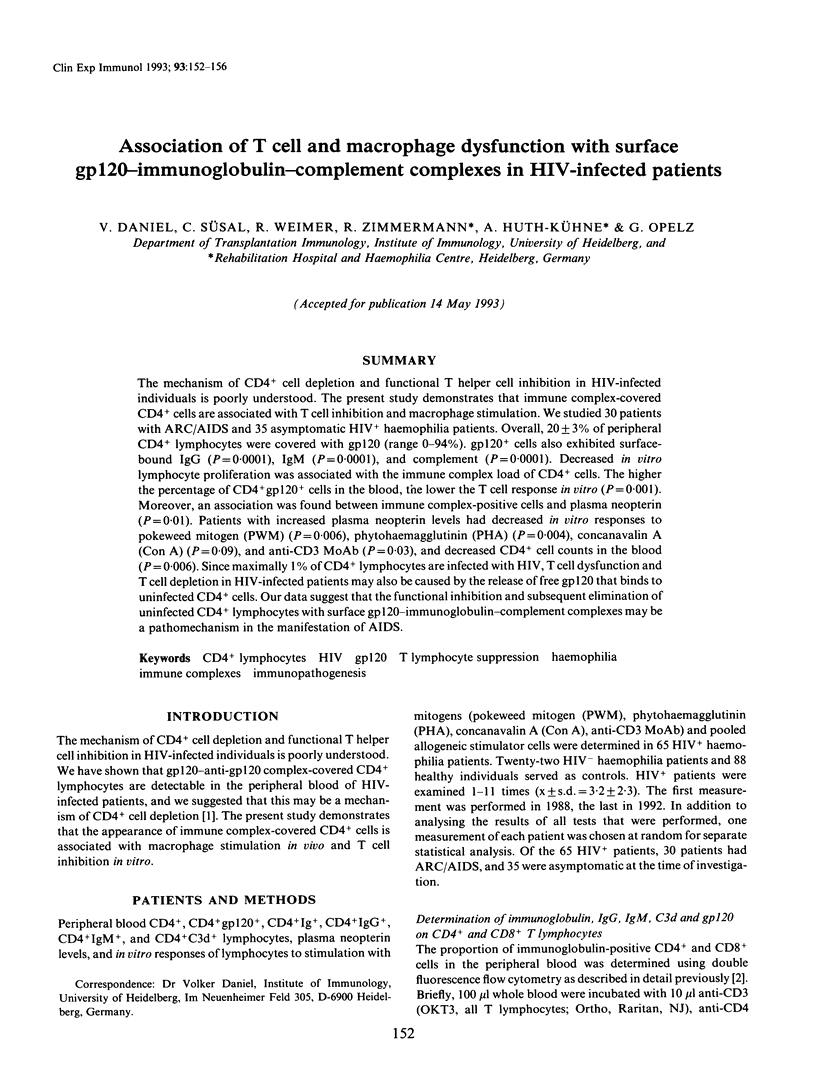
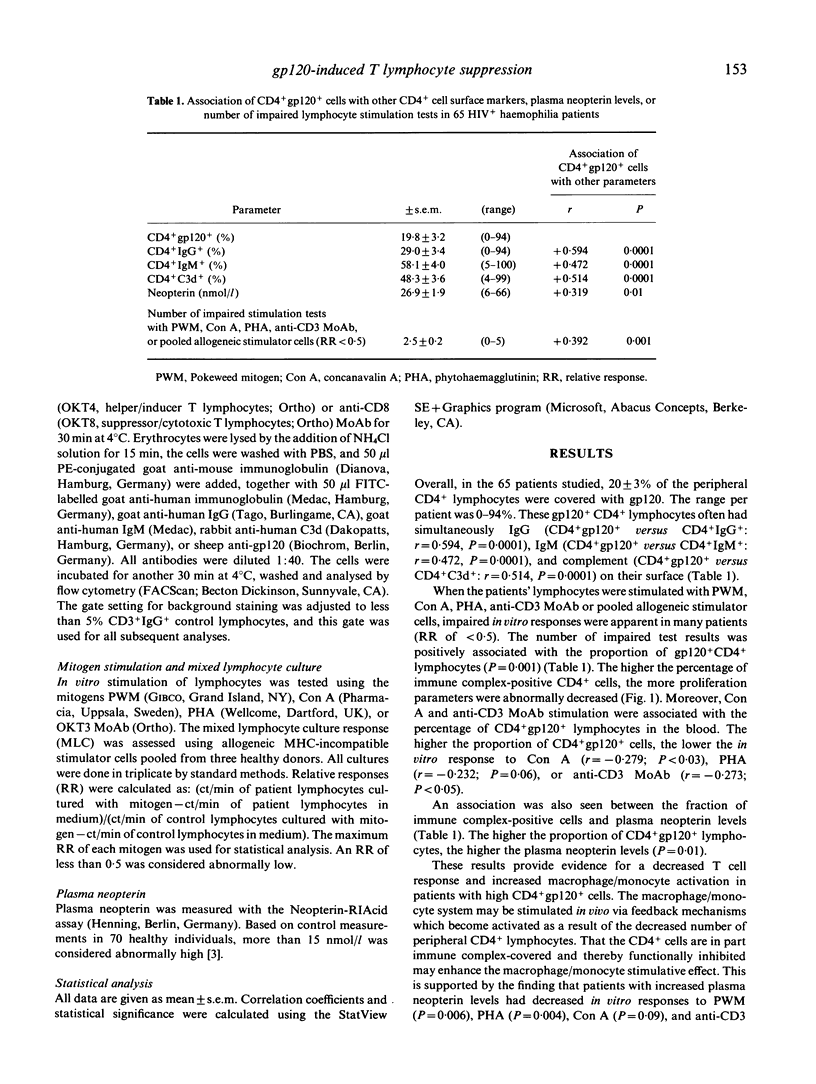
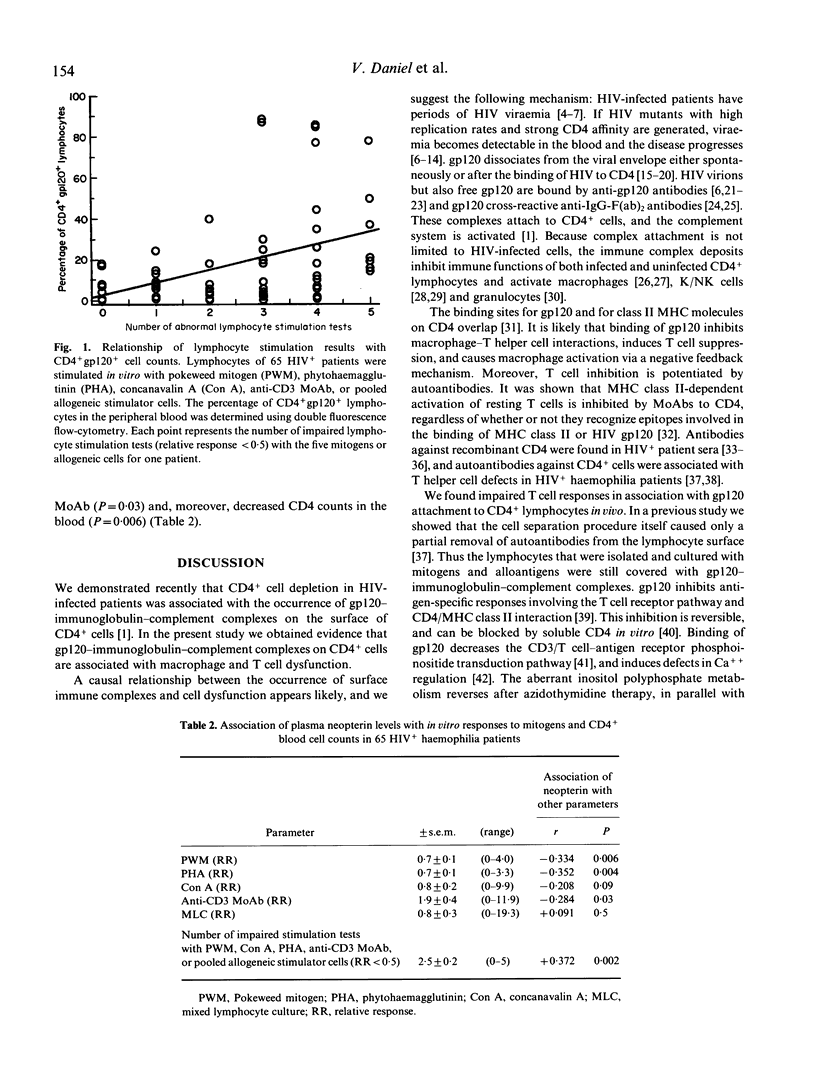
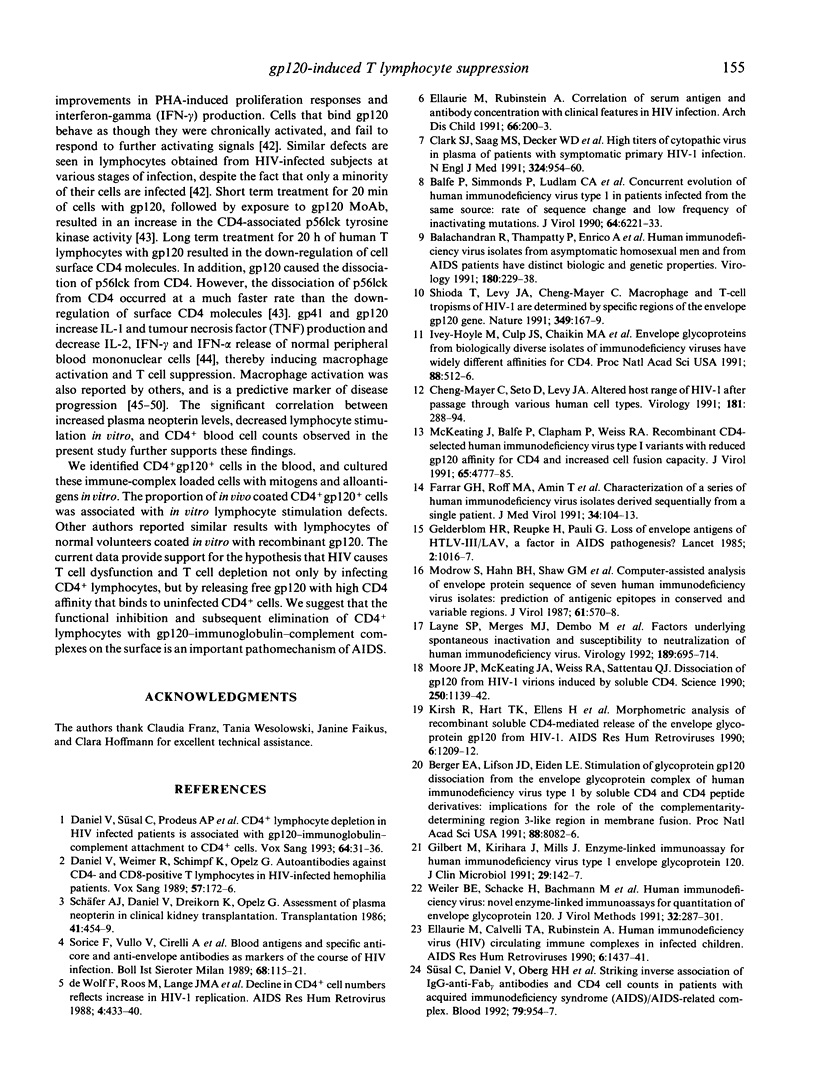
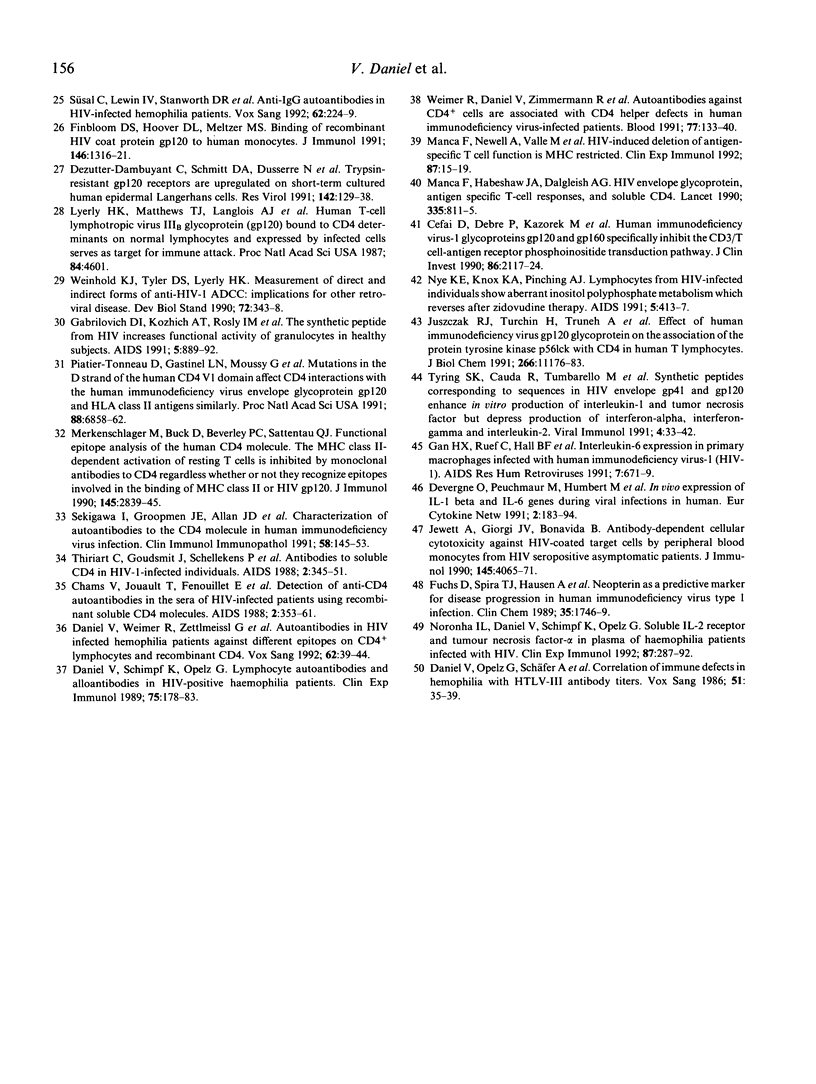
Selected References
These references are in PubMed. This may not be the complete list of references from this article.
- Balachandran R., Thampatty P., Enrico A., Rinaldo C., Gupta P. Human immunodeficiency virus isolates from asymptomatic homosexual men and from AIDS patients have distinct biologic and genetic properties. Virology. 1991 Jan;180(1):229–238. doi: 10.1016/0042-6822(91)90027-9. [DOI] [PubMed] [Google Scholar]
- Balfe P., Simmonds P., Ludlam C. A., Bishop J. O., Brown A. J. Concurrent evolution of human immunodeficiency virus type 1 in patients infected from the same source: rate of sequence change and low frequency of inactivating mutations. J Virol. 1990 Dec;64(12):6221–6233. doi: 10.1128/jvi.64.12.6221-6233.1990. [DOI] [PMC free article] [PubMed] [Google Scholar]
- Berger E. A., Lifson J. D., Eiden L. E. Stimulation of glycoprotein gp120 dissociation from the envelope glycoprotein complex of human immunodeficiency virus type 1 by soluble CD4 and CD4 peptide derivatives: implications for the role of the complementarity-determining region 3-like region in membrane fusion. Proc Natl Acad Sci U S A. 1991 Sep 15;88(18):8082–8086. doi: 10.1073/pnas.88.18.8082. [DOI] [PMC free article] [PubMed] [Google Scholar]
- Cefai D., Debre P., Kaczorek M., Idziorek T., Autran B., Bismuth G. Human immunodeficiency virus-1 glycoproteins gp120 and gp160 specifically inhibit the CD3/T cell-antigen receptor phosphoinositide transduction pathway. J Clin Invest. 1990 Dec;86(6):2117–2124. doi: 10.1172/JCI114950. [DOI] [PMC free article] [PubMed] [Google Scholar]
- Chams V., Jouault T., Fenouillet E., Gluckman J. C., Klatzmann D. Detection of anti-CD4 autoantibodies in the sera of HIV-infected patients using recombinant soluble CD4 molecules. AIDS. 1988 Oct;2(5):353–361. doi: 10.1097/00002030-198810000-00004. [DOI] [PubMed] [Google Scholar]
- Cheng-Mayer C., Seto D., Levy J. A. Altered host range of HIV-1 after passage through various human cell types. Virology. 1991 Mar;181(1):288–294. doi: 10.1016/0042-6822(91)90494-v. [DOI] [PubMed] [Google Scholar]
- Clark S. J., Saag M. S., Decker W. D., Campbell-Hill S., Roberson J. L., Veldkamp P. J., Kappes J. C., Hahn B. H., Shaw G. M. High titers of cytopathic virus in plasma of patients with symptomatic primary HIV-1 infection. N Engl J Med. 1991 Apr 4;324(14):954–960. doi: 10.1056/NEJM199104043241404. [DOI] [PubMed] [Google Scholar]
- Daniel V., Opelz G., Schäfer A., Schimpf K., Wendler I., Hunsmann G. Correlation of immune defects in hemophilia with HTLV-III antibody titers. Vox Sang. 1986;51(1):35–39. doi: 10.1111/j.1423-0410.1986.tb00205.x. [DOI] [PubMed] [Google Scholar]
- Daniel V., Schimpf K., Opelz G. Lymphocyte autoantibodies and alloantibodies in HIV-positive haemophilia patients. Clin Exp Immunol. 1989 Feb;75(2):178–183. [PMC free article] [PubMed] [Google Scholar]
- Daniel V., Süsal C., Prodeus A. P., Weimer R., Zimmermann R., Huth-Kühne A., Opelz G. CD4+ lymphocyte depletion in HIV-infected patients is associated with gp120-immunoglobulin-complement attachment to CD4+ cells. Vox Sang. 1993;64(1):31–36. doi: 10.1111/j.1423-0410.1993.tb02511.x. [DOI] [PubMed] [Google Scholar]
- Daniel V., Weimer R., Schimpf K., Opelz G. Autoantibodies against CD4- and CD8-positive T lymphocytes in HIV-infected hemophilia patients. Vox Sang. 1989;57(3):172–176. doi: 10.1111/j.1423-0410.1989.tb00817.x. [DOI] [PubMed] [Google Scholar]
- Daniel V., Weimer R., Zettlmeissl G., Langner K., Zimmermann R., Opelz G. Autoantibodies in HIV-infected hemophilia patients against different epitopes on CD4+ lymphocytes and recombinant CD4. Vox Sang. 1992;62(1):39–44. doi: 10.1111/j.1423-0410.1992.tb01165.x. [DOI] [PubMed] [Google Scholar]
- De Wolf F., Roos M., Lange J. M., Houweling J. T., Coutinho R. A., van der Noordaa J., Schellekens P. T., Goudsmit J. Decline in CD4+ cell numbers reflects increase in HIV-1 replication. AIDS Res Hum Retroviruses. 1988 Dec;4(6):433–440. doi: 10.1089/aid.1988.4.433. [DOI] [PubMed] [Google Scholar]
- Devergne O., Peuchmaur M., Humbert M., Navratil E., Leger-Ravet M. B., Crevon M. C., Petit M. A., Galanaud P., Emilie D. In vivo expression of IL-1 beta and IL-6 genes during viral infections in human. Eur Cytokine Netw. 1991 May-Jun;2(3):183–194. [PubMed] [Google Scholar]
- Dezutter-Dambuyant C., Schmitt D. A., Dusserre N., Hanau D., Kolbe H. V., Kieny M. P., Gazzolo L., Macé K., Pasquali J. L., Olivier R. Trypsin-resistant gp120 receptors are upregulated on short-term cultured human epidermal Langerhans cells. Res Virol. 1991 Mar-Jun;142(2-3):129–138. doi: 10.1016/0923-2516(91)90049-9. [DOI] [PubMed] [Google Scholar]
- Ellaurie M., Calvelli T. A., Rubinstein A. Human immunodeficiency virus (HIV) circulating immune complexes in infected children. AIDS Res Hum Retroviruses. 1990 Dec;6(12):1437–1441. doi: 10.1089/aid.1990.6.1437. [DOI] [PubMed] [Google Scholar]
- Ellaurie M., Rubinstein A. Correlation of serum antigen and antibody concentration with clinical features in HIV infection. Arch Dis Child. 1991 Feb;66(2):200–203. doi: 10.1136/adc.66.2.200. [DOI] [PMC free article] [PubMed] [Google Scholar]
- Farrar G. H., Roff M. A., Amin T., Ball J., Parrett A. M., Battacharyya U., Booth J., Wansbrough-Jones M. H., Greenaway P. J. Characterisation of a series of human immunodeficiency virus isolates derived sequentially from a single patient. J Med Virol. 1991 Jun;34(2):104–113. doi: 10.1002/jmv.1890340207. [DOI] [PubMed] [Google Scholar]
- Finbloom D. S., Hoover D. L., Meltzer M. S. Binding of recombinant HIV coat protein gp120 to human monocytes. J Immunol. 1991 Feb 15;146(4):1316–1321. [PubMed] [Google Scholar]
- Fuchs D., Spira T. J., Hausen A., Reibnegger G., Werner E. R., Felmayer G. W., Wachter H. Neopterin as a predictive marker for disease progression in human immunodeficiency virus type 1 infection. Clin Chem. 1989 Aug;35(8):1746–1749. [PubMed] [Google Scholar]
- Gabrilovich D. I., Kozhich A. T., Rosly I. M., Suvorova Z. K., Ivanov V. S., Moshnikov S. A., Tchikin L. D., Melichov V. I., Pokrovsky V. V. The synthetic peptide from HIV increases functional activity of granulocytes in healthy subjects. AIDS. 1991 Jul;5(7):889–892. doi: 10.1097/00002030-199107000-00016. [DOI] [PubMed] [Google Scholar]
- Gan H. X., Ruef C., Hall B. F., Tobin E., Remold H. G., Mellors J. W. Interleukin-6 expression in primary macrophages infected with human immunodeficiency virus-1 (HIV-1). AIDS Res Hum Retroviruses. 1991 Aug;7(8):671–679. doi: 10.1089/aid.1991.7.671. [DOI] [PubMed] [Google Scholar]
- Gelderblom H. R., Reupke H., Pauli G. Loss of envelope antigens of HTLV-III/LAV, a factor in AIDS pathogenesis? Lancet. 1985 Nov 2;2(8462):1016–1017. doi: 10.1016/s0140-6736(85)90570-7. [DOI] [PubMed] [Google Scholar]
- Gilbert M., Kirihara J., Mills J. Enzyme-linked immunoassay for human immunodeficiency virus type 1 envelope glycoprotein 120. J Clin Microbiol. 1991 Jan;29(1):142–147. doi: 10.1128/jcm.29.1.142-147.1991. [DOI] [PMC free article] [PubMed] [Google Scholar]
- Ivey-Hoyle M., Culp J. S., Chaikin M. A., Hellmig B. D., Matthews T. J., Sweet R. W., Rosenberg M. Envelope glycoproteins from biologically diverse isolates of immunodeficiency viruses have widely different affinities for CD4. Proc Natl Acad Sci U S A. 1991 Jan 15;88(2):512–516. doi: 10.1073/pnas.88.2.512. [DOI] [PMC free article] [PubMed] [Google Scholar]
- Jewett A., Giorgi J. V., Bonavida B. Antibody-dependent cellular cytotoxicity against HIV-coated target cells by peripheral blood monocytes from HIV seropositive asymptomatic patients. J Immunol. 1990 Dec 15;145(12):4065–4071. [PubMed] [Google Scholar]
- Juszczak R. J., Turchin H., Truneh A., Culp J., Kassis S. Effect of human immunodeficiency virus gp120 glycoprotein on the association of the protein tyrosine kinase p56lck with CD4 in human T lymphocytes. J Biol Chem. 1991 Jun 15;266(17):11176–11183. [PubMed] [Google Scholar]
- Kirsh R., Hart T. K., Ellens H., Miller J., Petteway S. A., Jr, Lambert D. M., Leary J., Bugelski P. J. Morphometric analysis of recombinant soluble CD4-mediated release of the envelope glycoprotein gp120 from HIV-1. AIDS Res Hum Retroviruses. 1990 Oct;6(10):1209–1212. doi: 10.1089/aid.1990.6.1209. [DOI] [PubMed] [Google Scholar]
- Layne S. P., Merges M. J., Dembo M., Spouge J. L., Conley S. R., Moore J. P., Raina J. L., Renz H., Gelderblom H. R., Nara P. L. Factors underlying spontaneous inactivation and susceptibility to neutralization of human immunodeficiency virus. Virology. 1992 Aug;189(2):695–714. doi: 10.1016/0042-6822(92)90593-e. [DOI] [PubMed] [Google Scholar]
- Lyerly H. K., Matthews T. J., Langlois A. J., Bolognesi D. P., Weinhold K. J. Human T-cell lymphotropic virus IIIB glycoprotein (gp120) bound to CD4 determinants on normal lymphocytes and expressed by infected cells serves as target for immune attack. Proc Natl Acad Sci U S A. 1987 Jul;84(13):4601–4605. doi: 10.1073/pnas.84.13.4601. [DOI] [PMC free article] [PubMed] [Google Scholar]
- Manca F., Habeshaw J. A., Dalgleish A. G. HIV envelope glycoprotein, antigen specific T-cell responses, and soluble CD4. Lancet. 1990 Apr 7;335(8693):811–815. doi: 10.1016/0140-6736(90)90935-x. [DOI] [PubMed] [Google Scholar]
- Manca F., Newell A., Valle M., Habeshaw J., Dalgleish A. G. HIV-induced deletion of antigen-specific T cell function is MHC restricted. Clin Exp Immunol. 1992 Jan;87(1):15–19. doi: 10.1111/j.1365-2249.1992.tb06406.x. [DOI] [PMC free article] [PubMed] [Google Scholar]
- McKeating J., Balfe P., Clapham P., Weiss R. A. Recombinant CD4-selected human immunodeficiency virus type 1 variants with reduced gp120 affinity for CD4 and increased cell fusion capacity. J Virol. 1991 Sep;65(9):4777–4785. doi: 10.1128/jvi.65.9.4777-4785.1991. [DOI] [PMC free article] [PubMed] [Google Scholar]
- Merkenschlager M., Buck D., Beverley P. C., Sattentau Q. J. Functional epitope analysis of the human CD4 molecule. The MHC class II-dependent activation of resting T cells is inhibited by monoclonal antibodies to CD4 regardless whether or not they recognize epitopes involved in the binding of MHC class II or HIV gp120. J Immunol. 1990 Nov 1;145(9):2839–2845. [PubMed] [Google Scholar]
- Modrow S., Hahn B. H., Shaw G. M., Gallo R. C., Wong-Staal F., Wolf H. Computer-assisted analysis of envelope protein sequences of seven human immunodeficiency virus isolates: prediction of antigenic epitopes in conserved and variable regions. J Virol. 1987 Feb;61(2):570–578. doi: 10.1128/jvi.61.2.570-578.1987. [DOI] [PMC free article] [PubMed] [Google Scholar]
- Moore J. P., McKeating J. A., Weiss R. A., Sattentau Q. J. Dissociation of gp120 from HIV-1 virions induced by soluble CD4. Science. 1990 Nov 23;250(4984):1139–1142. doi: 10.1126/science.2251501. [DOI] [PubMed] [Google Scholar]
- Noronha I. L., Daniel V., Schimpf K., Opelz G. Soluble IL-2 receptor and tumour necrosis factor-alpha in plasma of haemophilia patients infected with HIV. Clin Exp Immunol. 1992 Feb;87(2):287–292. doi: 10.1111/j.1365-2249.1992.tb02989.x. [DOI] [PMC free article] [PubMed] [Google Scholar]
- Nye K. E., Knox K. A., Pinching A. J. Lymphocytes from HIV-infected individuals show aberrant inositol polyphosphate metabolism which reverses after zidovudine therapy. AIDS. 1991 Apr;5(4):413–417. doi: 10.1097/00002030-199104000-00009. [DOI] [PubMed] [Google Scholar]
- Piatier-Tonneau D., Gastinel L. N., Moussy G., Bénichou B., Amblard F., Vaigot P., Auffray C. Mutations in the D strand of the human CD4 V1 domain affect CD4 interactions with the human immunodeficiency virus envelope glycoprotein gp120 and HLA class II antigens similarly. Proc Natl Acad Sci U S A. 1991 Aug 1;88(15):6858–6862. doi: 10.1073/pnas.88.15.6858. [DOI] [PMC free article] [PubMed] [Google Scholar]
- Schäfer A. J., Daniel V., Dreikorn K., Opelz G. Assessment of plasma neopterin in clinical kidney transplantation. Transplantation. 1986 Apr;41(4):454–459. doi: 10.1097/00007890-198604000-00008. [DOI] [PubMed] [Google Scholar]
- Sekigawa I., Groopmen J. E., Allan J. D., Ikeuchi K., Biberfield G., Takatsuki K., Byrn R. A. Characterization of autoantibodies to the CD4 molecule in human immunodeficiency virus infection. Clin Immunol Immunopathol. 1991 Jan;58(1):145–153. doi: 10.1016/0090-1229(91)90156-5. [DOI] [PubMed] [Google Scholar]
- Shioda T., Levy J. A., Cheng-Mayer C. Macrophage and T cell-line tropisms of HIV-1 are determined by specific regions of the envelope gp120 gene. Nature. 1991 Jan 10;349(6305):167–169. doi: 10.1038/349167a0. [DOI] [PubMed] [Google Scholar]
- Sorice F., Vullo V., Cirelli A., Catania S., Mastroianni C. M., Contini C., Delia S. Antigenemia ed anticorpi specifici anti-core ed anti-envelope quali markers di evoluzione dell'infezione da HIV. Boll Ist Sieroter Milan. 1989;68(2):115–121. [PubMed] [Google Scholar]
- Süsal C., Daniel V., Oberg H. H., Terness P., Huth-Kühne A., Zimmerman R., Opelz G. Striking inverse association of IgG-anti-Fab gamma antibodies and CD4 cell counts in patients with acquired immunodeficiency syndrome (AIDS)/AIDS-related complex. Blood. 1992 Feb 15;79(4):954–957. [PubMed] [Google Scholar]
- Süsal C., Lewin I. V., Stanworth D. R., Terness P., Daniel V., Oberg H. H., Huth-Kühne A., Zimmermann R., Opelz G. Anti-IgG autoantibodies in HIV-infected hemophilia patients. Vox Sang. 1992;62(4):224–229. doi: 10.1111/j.1423-0410.1992.tb01203.x. [DOI] [PubMed] [Google Scholar]
- Thiriart C., Goudsmit J., Schellekens P., Barin F., Zagury D., De Wilde M., Bruck C. Antibodies to soluble CD4 in HIV-1-infected individuals. AIDS. 1988 Oct;2(5):345–351. doi: 10.1097/00002030-198810000-00003. [DOI] [PubMed] [Google Scholar]
- Tyring S. K., Cauda R., Tumbarello M., Ortona L., Kennedy R. C., Chanh T. C., Kanda P. Synthetic peptides corresponding to sequences in HIV envelope gp41 and gp120 enhance in vitro production of interleukin-1 and tumor necrosis factor but depress production of interferon-alpha, interferon-gamma and interleukin-2. Viral Immunol. 1991 Spring;4(1):33–42. doi: 10.1089/vim.1991.4.33. [DOI] [PubMed] [Google Scholar]
- Weiler B. E., Schäcke H., Bachmann M., Brigido L., Gilbert M., Mills J., Matthes E., Forrest J. M., Müller W. E. Human immunodeficiency virus: novel enzyme-linked immunoassays for quantitation of envelope glycoprotein 120. J Virol Methods. 1991 May;32(2-3):287–301. doi: 10.1016/0166-0934(91)90059-9. [DOI] [PubMed] [Google Scholar]
- Weinhold K. J., Tyler D. S., Lyerly H. K. Measurement of direct and indirect forms of anti-HIV-1 ADCC: implications for other retroviral disease. Dev Biol Stand. 1990;72:343–348. [PubMed] [Google Scholar]


